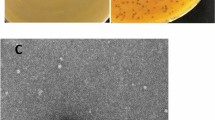Abstract
Emergence of multidrug resistant strains has created serious problem for safe eradication of Staphylococcus aureus infections. Therefore, there is an urgent need to develop novel antibacterial agents to control this pathogen. Bacteriophages kill bacteria irrespective of their antibiotic sensitivity and thus they can be used as potent prophylactic/therapeutic agent to treat such infections. Here, we report isolation of broad host range anti-staphylococcal lytic bacteriophage P-27/HP from sewage water. This phage was able to inhibit 17 of 28 (60%) human disease associated S. aureus isolates. In vitro studies revealed its strong lytic efficacy to diminish S. aureus 27/HP population (c.f.u.) by more than 5.0 logs (P < 0.0001) (equivalent to 99.99%) in 3 h at 0.01 MOI. In vivo lytic efficacy analysis showed that a single subcutaneous injection of phage P-27/HP (107 p.f.u.) was sufficient to protect S. aureus 27/HP infected (5 × 108 c.f.u.) mice from bacteremia and subsequent death. A considerable decline of more than 6 logs (99.9%) in splenic S. aureus 27/HP c.f.u. count was noted at the 3 days of phage treatment. In conclusion, our results suggest that phage P-27/HP is polyvalent in nature and has high-lytic potential towards S. aureus, thus, a therapy employing this phage would be efficacious to control S. aureus infections.



Similar content being viewed by others
References
Adams MH (1959) Bacteriophages. Interscience, New York
Anupurba S, Sen MR, Nath G et al (2003) Prevalence of methicillin resistance Staphylococcus aureus in a tertiary referral hospital in eastern Uttar Pradesh. Indian J Med Microbiol 21(1):49–51
Capparelli R, Parlato M, Borriello G et al (2007) Experimental phage therapy against Staphylococcus aureus in mice. Antimicrob Agents Chemother 51:2765–2773. doi:10.1128/AAC.01513-06
Casey AL, Lambert PA, Elliott TSJ (2007) Staphylococci. Int J Antimicrob Agents 29(3):S23–S32. doi:10.1016/S0924-8579(07)72175-1
Chamber HF (2005) Community-associated MRSA—resistance and virulence converge. New Engl J Med 352:1485–1487
Cowan ST, Steel KJ (1975) Manual for identification of medical bacteria. Cambridge University press, London
El-Jakee J, Nagwa AS, Bakry M et al (2008) Characteristics of Staphylococcus aureus strains isolated from human and animal sources. Am Eurasian J Agric Environ Sci 4(2):221–229
Eisenstark A (1967) Bacteriophage techniques. In: Maramorsch K, Koprowski H (eds) Methods in virology 1. Academic press, New York, pp 449–524
Gorski A, Miedzybrodzki R, Borysowski J et al (2009) Bacteriophage therapy for the treatment of infections. Curr Opin Investig Drugs 10(8):766–774
Jernigan JA, Farr BM (1993) Short-course therapy of catheter-related Staphylococcus aureus bacteremia: a meta-analysis. Ann Intern Med 119:304–311
Lowy FD (2003) Antimicrobial resistance: the example of Staphylococcus aureus. J Clin Invest 111:1265–1273. doi:10.1172/JCI200318535
Matsuzaki S, Yasuda M, Nishikawa H et al (2003) Experimental protection of mice against lethal Staphylococcus aureus infection by novel bacteriophage phi MR11. J Infect Dis 187:613–624. doi:10.1086/374001
Merabishvili M, Pirnay JP, Verbeken G et al (2009) Quality-controlled small-scale production of a well-defined bacteriophage cocktail for use in human clinical trials. PLoS One 4(3):e4944. doi:10.1371/journal.pone.0004944
National Committee for Clinical Laboratory Standards (2000) Performance standards for antimicrobial disk susceptibility tests: approved standard M2-A6, 7th edn. NCCLS, Wayne, PA
O’Flaherty S, Ross RP, Meaney W et al (2005) Potential of the polyvalent anti-Staphylococcus bacteriophage K for the control of antibiotic-resistant staphylococci from hospitals. Appl Environ Microbiol 71:1836–1842. doi:10.1128/AEM.71.4.1836-1842.2005
O’Flaherty S, Ross RP, Coffey A (2009) Bacteriophage and their lysins for elimination of infectious bacteria. FEMS Microbiol Rev 33:801–819. doi:10.1111/j.1574-6976.2009.00176.x
Service RF (2004) Orphan drugs of the future? Science 303:1798. doi:10.1126/science.303.5665.1798
Sulakvelidze A, Alavidze Z, Morris JG Jr (2001) Bacteriophage therapy. Antimicrob Agents Chemother 45:649–659. doi:10.1128/AAC.45.3.649-659.2001
Synnott AJ, Kuang Y, Kurimoto M et al (2009) Isolation from sewage influent and characterization of novel Staphylococcus aureus bacteriophages with wide host ranges and potent lytic capabilities. Appl Environ Microbiol 4483–4490. doi:10.1128/AEM.02641-08
Wenzel RP, Bearman G, Edmond MB (2007) Community-acquired methicillin-resistant Staphylococcus aureus (MRSA): new issues for infection control. Int J Antimicrob Agents 30:210–212. doi:10.1016/j.ijantimicag.2007.04.003
Author information
Authors and Affiliations
Corresponding author
Rights and permissions
About this article
Cite this article
Gupta, R., Prasad, Y. Efficacy of Polyvalent Bacteriophage P-27/HP to Control Multidrug Resistant Staphylococcus aureus Associated with Human Infections. Curr Microbiol 62, 255–260 (2011). https://doi.org/10.1007/s00284-010-9699-x
Received:
Accepted:
Published:
Issue Date:
DOI: https://doi.org/10.1007/s00284-010-9699-x




